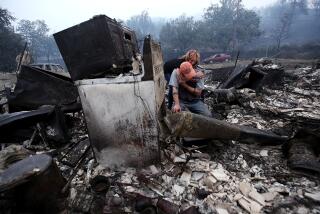Asbestos: A Mini Profile
The following facts point to some of the characteristics, merits and drawbacks of asbestos, a natural substance labeled both a blessing and a curse, depending on when, where and how it has been viewed or handled in the course of history.
People are naturally exposed to asbestos, and exposure to its fibers may not necessarily result in disease. However, according to the American Lung Assn., that chance increases with exposure, and individuals who both smoke and are exposed to hazardous levels of airborne asbestos fibers face an added risk of developing lung cancer as the two carcinogens multiply the effect.
Known as the “magic mineral” for its extraordinary fire-retardant qualities and versatility, it is found in rock formations everywhere.
Chrysotile, which accounts for 95% of the world’s production of asbestos, comes from the mineral serpentine that is often mistaken for jade and is extensively used in moderately priced jewelry.
As a result of both its natural occurrence and commercial use in the United States, asbestos fibers are commonly found in water supplies and in the air.
The U. S. Environmental Protection Agency, in broad samples of local water supplies, detected naturally occurring asbestos in nearly three-fourths of all U. S. water systems. More than 15% had in excess of 250,000 fibers per eight-ounce glass.
Some asbestos fibers are long enough for spinning, usually blend with cotton or rayon to add strength and are woven into fabrics and made into safety clothing, gloves, helmets, awnings, and used in conveyor belts carrying hot materials.
Marco Polo reported that he saw asbestos cloth in Siberia. The first factory for making asbestos cloth was operated in Russia in the 1700s; today, that production is centered in the United States.
Both its thermal and electrical resistance, as well as its stability in acids or alkalis led to wide use of asbestos in ships, buildings and in theater curtains, where protection from fire was essential.
Charlemagne, king of the Franks and emperor of the Holy Roman Empire in the 9th Century, is said to have impressed foreign visitors by throwing an asbestos tablecloth into the flames to be cleaned.
Products containing asbestos, in recent times, were most widely used in school construction, from the period immediately following World War II to the early ‘70s, and were often mandated by building codes and municipal regulations.
The Environmental Protection Agency estimates the risk experienced by attending a school with O.001-fibers-per-cubic-centimeter average asbestos exposure would be the equivalent to the risk a person would experience smoking five cigarettes or living with a smoker for seven months.
The most serious risks are a direct cause of improper tampering or removal of asbestos and can be more hazardous than if not removed at all.
More to Read
Inside the business of entertainment
The Wide Shot brings you news, analysis and insights on everything from streaming wars to production — and what it all means for the future.
You may occasionally receive promotional content from the Los Angeles Times.










